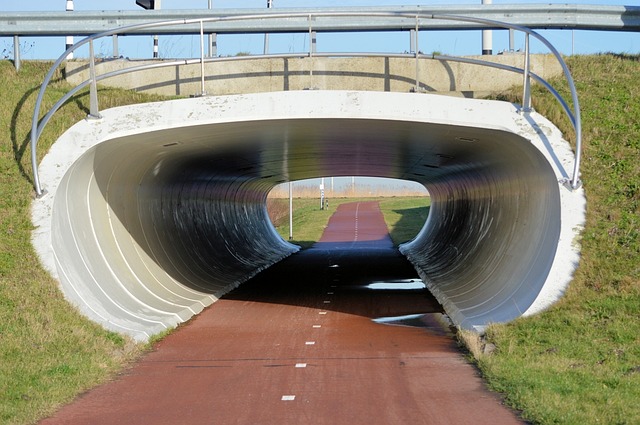Ground-penetrating radar (GPR) is a non-invasive, powerful technology for underground utility detection. It transmits high-frequency radio waves into the ground, measuring reflection times to create detailed images of subsurface utilities like pipes and cables. GPR aids in safe excavation, infrastructure maintenance, and construction planning by revealing utility locations, minimizing damage risks. Effectiveness depends on soil conditions, moisture levels, and target depth; combining GPR with other methods enhances accuracy. Meticulous planning, site understanding, and equipment calibration ensure reliable underground utility detection using GPR.
“Ground-penetrating radar (GPR) is a powerful tool for creating detailed images of what lies beneath the surface. This non-invasive technology has revolutionized various industries, particularly in the realm of underground utility detection. From locating buried pipes and cables to mapping complex infrastructure networks, GPR offers unprecedented accuracy and efficiency.
In this article, we’ll explore the inner workings of GPR technology, its diverse applications in underground utility detection, and the unique advantages it brings over traditional methods. We’ll also delve into best practices for effective implementation.”
Understanding Ground-Penetrating Radar Technology
Ground-penetrating radar (GPR) is a powerful technology that enables detailed imaging of what lies beneath the Earth’s surface. It works by transmitting high-frequency radio waves into the ground and measuring the time it takes for them to bounce back after encountering different materials or structures. This process creates an image of the subsurface, revealing the presence and depth of various objects, including underground utility lines.
By utilizing different frequencies and transmission methods, GPR can penetrate various materials such as soil, concrete, and rock, offering a non-invasive way to detect and map utilities like pipes, cables, and foundations. This technology is invaluable for construction projects, archaeological research, and infrastructure maintenance, ensuring that any excavation or drilling activities are carried out safely and efficiently while avoiding potential damage to critical underground utilities.
Applications of GPR in Underground Utility Detection
Ground-penetrating radar (GPR) has become an indispensable tool for detailed subsurface imaging, offering a non-invasive method to map and detect utilities beneath the Earth’s surface. This technology is particularly valuable in urban settings where accurate underground utility detection is essential for construction and maintenance projects. By transmitting high-frequency electromagnetic waves into the ground, GPR can create precise images of underlying structures, such as pipes, cables, and buried objects.
In the realm of underground utility detection, GPR provides several key applications. It allows professionals to identify and locate utilities without disturbing the ground, minimizing excavation risks and costs. This is crucial in areas where critical infrastructure lies close to the surface or in tight spaces, enabling efficient and safe project planning. Moreover, GPR can assist in asset management by providing up-to-date information on the condition and location of underground utilities, facilitating better decision-making for maintenance, upgrades, and new installations.
Advantages and Limitations of Using Ground-Penetrating Radar
Ground-penetrating radar (GPR) offers several advantages for detailed subsurface imaging, making it a valuable tool in various industries. One of its key strengths is the ability to create high-resolution images of the underground, providing insights into the location and extent of objects or structures embedded within. This non-invasive technique is particularly useful for underground utility detection, enabling professionals to identify pipelines, cables, and other critical infrastructure without disturbing the surface. By sending electromagnetic waves into the ground and analyzing the reflected signals, GPR can deliver precise data on subsurface features, making it indispensable in construction, engineering, and environmental monitoring projects.
Despite its capabilities, GPR also has limitations that should be considered. The quality of images generated depends heavily on factors such as soil type, moisture content, and the depth of the target. In areas with highly reflective or dense materials, like solid rock or metal, the signal penetration may be limited, resulting in less detailed scans. Additionally, GPR can be sensitive to surface disturbances, which might cause interference or affect the accuracy of the data collected. These limitations highlight the importance of combining GPR with other geophysical methods for comprehensive subsurface exploration and mapping.
Best Practices for Effective GPR Implementation
When implementing Ground-Penetrating Radar (GPR) for detailed subsurface imaging, especially in underground utility detection, adhering to best practices is paramount. These include meticulous planning and preparation, ensuring clear understanding of site conditions, and selecting appropriate antenna configurations for the specific depth and resolution required. A crucial step is conducting thorough pre-scanning surveys to establish baseline data, which helps in identifying potential interference sources and anomalies.
During actual scanning, maintaining consistent speed and pressure while scanning ensures accurate data collection. Additionally, utilizing advanced data processing techniques, such as signal deconvolution and image enhancement algorithms, significantly improves the quality of subsurface images. Regular calibration and maintenance of GPR equipment are also essential to guarantee precise and reliable results in underground utility detection applications.
Ground-penetrating radar (GPR) has emerged as a powerful tool for detailed subsurface imaging, with numerous applications in underground utility detection. By understanding its technology, leveraging its advantages, and adhering to best practices, professionals can ensure effective implementation of GPR. This innovative method offers unparalleled insights into the subterranean world, revolutionizing how we navigate and maintain our infrastructure. For efficient underground utility detection, GPR is an indispensable asset, enabling precise identification and mapping of utilities for safer and more informed decision-making.
